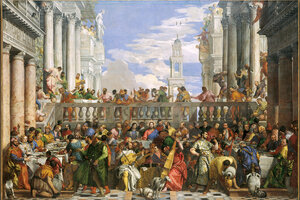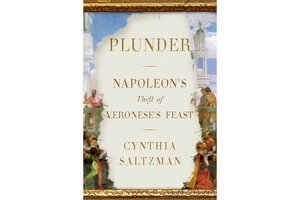Napoleon plundered Europe’s art to bring prestige home to France
“Plunder” digs deep into Napoleon’s theft of artworks across conquered Europe in his effort to enrich the Louvre and solidify French dominance.

“The Wedding Feast at Cana," completed by Paolo Veronese in 1563, was carted out of Italy to Paris under Napoleon’s orders. Today, it is a centerpiece of the Louvre Museum’s collection.
Courtesy of © RMN-Grand Palais/Art Resource NY/Farrar, Straus and Giroux
As his armies conquered most of Europe, Napoleon Bonaparte demonstrated an insatiable desire to steal art. These were not smash-and-grab operations. According to Cynthia Saltzman’s marvelous book, “Plunder: Napoleon’s Theft of Veronese’s Feast,” he sought out experts to advise him on which cultural treasures to ship back to Paris. Napoleon wanted to expand the art collection in the Louvre palace. He wrote to France’s five-member governing committee to “send three or four known artists” to choose the best paintings and sculptures.
The peace treaties Napoleon imposed on defeated foes usually required artworks to be forfeited. A 1796 treaty with Pope Pius VI, for example, was worded: “The Pope shall deliver to the French Republic one hundred paintings, busts, vases or statues at the choice of the Commissioners who will be sent to Rome.” At one point he even boasted to the governing committee, “we have everything that is a work of art in Italy, save for a small number of objects in Turin and Naples.”
The French justified this theft not only as part of the spoils of war but also as a way of demonstrating the French Republic’s dominant position in Europe’s new military, political, and cultural order, Saltzman writes. Possessing these objects would demonstrate “their passion for knowledge, their respect for history, their discipline, rationality, and expertise in the fine arts.”
Saltzman tells this story by focusing on the fate of one particular masterpiece: Paolo Veronese’s “The Wedding Feast at Cana.” Painted for the monastery of San Giorgio Maggiore in Venice in 1563, the painting recounts Jesus’ first miracle, the changing of water into wine. The giant canvas measures 22 feet by 33 feet and includes 130 life-size figures arranged across a richly colored and beautifully painted canvas.
Looting is a messy business, however, and fragile paintings are easily damaged. As Saltzman details, the French nearly destroyed the masterpiece when they ripped it from the wall. They damaged it further when they failed to protect it during the 10 months it took to transport the painting to the Louvre, and inflicted even more abuse on the canvas when they attempted to repair the damage they had caused. Saltzman’s description of this rough handling of an artistic masterpiece ought to carry a trigger warning for art lovers.
Napoleon’s armies would march for the next decade, and they stole artwork wherever they went. Spain, Portugal, the Low Countries, Italy, and Germany were all robbed of artworks that were then taken to Paris. Eventually, of course, the French leader overreached and the allies defeated him at Waterloo in 1815. In the process of putting Europe back together, they turned their attention to the art Napoleon had stolen.
Many objects were returned, but there were exceptions. One was the “The Wedding Feast at Cana.” The Louvre’s curators were – irony alert – able to convince the Italians that the canvas was so severely compromised that returning the work to Venice might well destroy it. In exchange, the French offered a relatively minor painting by Charles Le Brun. It was not a fair trade. But the broader negotiations were vast, and art restitution was a relatively small issue. So the Le Brun painting went to Venice and the Veronese stayed in Paris.
This is a gripping tale and Saltzman tells it well. Moving seamlessly between the broader narrative of Napoleon’s rise and fall, and the fate of one sublime painting, she tells a story that will captivate any reader with an interest in art history. The book is expertly and exhaustively researched, and it reads like a thriller.
There are plenty of villains and few heroes. And there are ironies aplenty. Richard Hamilton, a British diplomat, argued forcefully for returning the looted artwork. But 10 years before Napoleon’s defeat, Hamilton had helped Thomas Bruce, better known as Lord Elgin, move substantial parts of the Parthenon frieze to the British Museum. French fears that moving “The Wedding Feast at Cana” might harm the painting did not prevent them from rolling up the canvas and moving it multiple times during the Franco-Prussian War and World War II.
One cannot read this book without reflecting on the systematic looting of art by the Nazis during World War II. Napoleon did not steal on the same scale or with the same violence. But the systematic approach, the sense of entitlement, and the belief that the plundered works were a positive reflection on the culture that held them can all be seen more than a century before the Nazis took power.
“The Wedding Feast at Cana” remains one of the artistic treasures of Western civilization and a lightning rod for controversy. A restoration in the 1990s resulted in significant damage when the canvas fell. In 2010, a Venetian official wrote a letter to Carla Bruni, the wife of then-French President Nicolas Sarkozy, urging that the painting be returned. But it remains in the Louvre. Visitors to San Giorgio Maggiore see only a reproduction. To date, it would appear that Napoleon’s theft of this particular masterpiece has succeeded.


